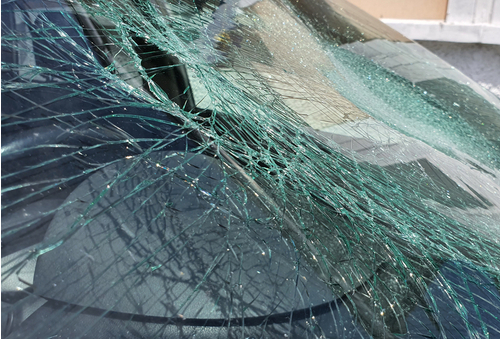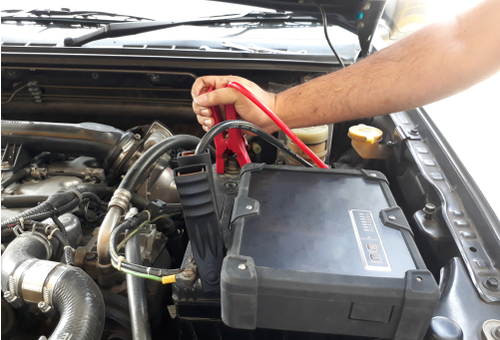
This writer learned a very expensive lesson when he was recently invited to program an LKAS (Lane Keeping Assist) camera on a two-year-old Nissan Sentra. It was not like the car, or any electronic components or systems on the car were damaged; the lesson involved the fact that this writer had failed to keep up with the latest developments in the programming power requirements of late-model Nissan vehicles. Before we get to the specific of this lesson, let us state-
This tale does not start with a defective LKAS camera. This tale starts with the owner of the Sentra taking the car to a tyre fitment centre (which belonged to an erstwhile colleague of this writer), to have the two front tyres replaced. Nobody expected the windscreen to be shattered in much the same way as the windscreen in the above image is shattered.
Anyhow, once the car was on a scissor jack and the two front wheels removed, one of the newly-installed sodium lights in the tyre centre broke free from its anchor, and since the new lights were all mounted directly above each workstation, the light fell directly on the Sentra’s windscreen, shattering it, and destroying the windscreen-mounted LKAS camera.
When this writer arrived at the tyre centre, the Sentra's shattered windscreen and LKAS camera had already been replaced with OEM parts by a nearby collision repairer that also ran an automotive glass fitment establishment from the same premises, so it seemed like a simple enough job to calibrate and program the camera. The car’s owner had also been notified of the mishap, and she was on her way to do and say what she was going to do and say. This writer was present to hear much of what she did say, but none of that is repeatable here, which brings us to-
As a first step, this writer checked to see that there was a warning light on the dashboard, which there was, and then proceeded to scan the entire vehicle with a high-end generic scan tool that featured advanced ADAS calibration capabilities, which produced trouble code C2503:54 - “Camera Aiming Incomplete”.
So far, so good, so we cleared a sufficiently large area around the vehicle for this writer to set up his Sentra-specific calibration targets. It should be noted that while some calibration procedures have become a lot less complex in recent years, the process of establishing the proper and correct distance, orientation, and relationship between the vehicle and calibration targets have, is anything, become more critical than before.
Other issues like glare-free lighting, a level floor, and the lack of magnetic material around the vehicle are also still required, and in this case, we could establish the required conditions within the tyre centre by moving and rearranging things.
Once we had the required conditions ready, this writer began orienting the calibration target. We can skip over the minutiae of this process, but for the most part, it involved hanging a plumb bob from the centre of the badges on both grille and the boot lid to establish the car's midline. Using this line as a reference, a four-way laser beam marked out the centre of the right front wheel, and the calibration target was set up at a distance of exactly 3 metres from the centre of the wheel. The next step was to make sure the aiming spots on the target was at the specified height from the floor, and that both aiming spots were placed at exactly 360mm on either side of the vehicle's midline.
There was a lot more, besides, but we are sure you get the point that calibration targets must be set up in very specific ways, including entering the measured distance between the centres of the front wheels and the floor into the scan tool. In this case, the software allowed a difference of 22mm, and since the observed difference was only 9mm, the software declared the set up complete, and programming could begin, which was when the trouble started so here is-

Making sure that the clean power supply he had brought along was plugged in and connected to the battery, this writer connected his scan tool and switched on the vehicle's ignition. Navigating to the relevant screen took only a few seconds, but then the scan tool produced this message – “NO COMMUNICATION”.
This had never happened before on any Nissan product, so this writer checked the clean power supply’s output voltage, which read 13.7 volts, as the scan tool said it must. Next, he disconnected the scan tool, reconnected it, but got the same “NO COMMUNICATION” message. In fact, the same message appeared at each of several subsequent attempts to establish communication with the vehicle.
At that point, it seemed unlikely that the scan tool was the problem since it had recently been updated to include the latest versions of calibration software for 2021 models from all major manufacturers. Nonetheless, the owner of the car was beginning to fidget and prowl around the car, so to speed things up, this writer called his office to have his Nissan-specific Consult 3+ scan tool brought over.
This took about 20 minutes or so, but connecting this very expensive tool did not solve our problems. While the relevant screen still showed the usual Self Diagnostic Codes, Data, ECU Info and Configuration tabs, the Work Support tab was missing. This tab contained all the bidirectional controls and commands one uses during ADAS module programming, but now, this tab had been replaced by a tab labelled "CGW", but worse, this tab was emphasized by a large red exclamation point.
This writer had never seen this tab appear before, but since the label resembled the abbreviations other manufacturers use to denote secure gateway modules, this writer opened the tab, which produced another new menu accompanied by another warning message but this time, the message appeared in a large red script that said; “VEHICLE IN RESTRICTED MODE”.
This could mean only one thing; like many other manufacturers, Nissan had begun to secure some models against unauthorised programming by potential hackers that often use jury-rigged equipment and stolen scan tools, among other things. So, like some other manufacturers, Nissan had placed a secured gateway module between the DLC and the vehicles' systems that could only be bypassed by entering a unique security code via an approved scan tool.
This writer was embarrassed to admit that he did not know that this particular Nissan model was protected in this way, and based on his experience with GM vehicles, the process of registering and purchasing a security code was not going to be quick or painless. Thus, a period of intense negotiation with the car's owner followed, during which it was agreed that the owner of the tyre fitment centre would provide her with a rented vehicle until we could get the LKAS camera issue resolved. We could of course, have referred the car to a dealership, but since it was then already way past closing time, we were on our own.
We can skip over the details of what followed next, except for saying that the process of registering this writer’s business details, as well as those of his Nissan-specific Consult 3+ scan tool on Nissan's dedicated (and very secure server), took up most of that night, but the less we say about the eye-watering cost of a one-year subscription, the better. Overall, the process of registration and payment took about 17 hours, but when the Nissan server unlocked the secure gateway module via the scan tool, we thought we were home free. However, it was not to be, because-
With full access to the vehicle’s control modules, the Work Support tab on the scan tool became available, but the first attempt to initiate the LKAS camera programming process produced this error message – “PROGRAMMING ABORTED”.
Despite this writer’s best efforts to run the process, the process always failed at the same point, until the scan tool provided this clue- “CHECK POWER SUPPLY”. This was weird because, upon checking, the power supply still delivered a constant 13.7 volts with no AC ripple current whatsoever. The current was at a steady 20 amps, and since this configuration had worked flawlessly many times on other Nissan products before, the root cause of the aborted programming attempts was somewhat less than clear.
By this time, however, it was already mid-morning and the car and the calibration targets were seriously hampering the workflow in the tyre fitment centre. It was also at this point that this writer remembered an invaluable lesson he had learned many years ago during his days as an apprentice, this lesson being- “IF ALL ELSE FAILS, READ THE MANUAL”.
We can skip over the details of what it took to obtain the relevant section in the manual, but in short, it said that the last thing this particular Nissan Sentra model wanted was a steady current during any type of programming or calibration procedure. Moreover, the manual also stated that the required voltage for this particular procedure was 14.2, and not the 13.7 volts this writer was using- even though this voltage had worked to program many different control modules successfully on many other Nissan products before.
Nonetheless, this writer had learned early on in his career that one can only work with what is in front of one, so in order not to waste more time, he perused this section of the manual for some time. In short, here is what it said-

For copyright reasons, we cannot reproduce the relevant sections of the manual here, but we can do the next best thing, which is to paraphrase the most pertinent points. So for reference purposes, this is what the Nissan Sentra’s manual said-
To improve the reliability and fault detection capabilities of control modules, as well as the speed of data transmission between different classes of control modules, Nissan's engineers have redefined the power needs of control modules, and particularly the power control modules need during programming.
For instance, the power needs of different control modules even within a particular model can range from greater than 12 volts to specific voltages, such as 13.4V, 13.7V, 14.2V, etc, with the LKAS camera module on this particular Sentra model requiring 14.2 volts during programming. Therefore, a clean power supply that delivers a steady voltage will serve to power only some control modules during programming. In practice, this means that to program the complete range of control modules on protected Nissan products, one needs a power supply that can be dialled to the specified voltage a particular control module needs for programming to complete. (Italics added)
Moreover, revisions to communication hierarchies on protected Nissan models also mean that a suitable power supply must be able to adapt currents (amperages) automatically to suit the changing demands for current that now occurs during any reprogramming procedure. For instance, and depending on the modules/system being programmed, current demand can vary from only a few amps to more than 100 amps at different times during the programming event.
In conclusion, the manual recommended that technicians only use power supply units that can not only adapt to changing current demands automatically in less than 10 milliseconds, but units that can also operate at the required voltages and currents indefinitely. To illustrate the point, the manual gave the following example(s)-
If the programming procedure requires a demand of 7 amps to maintain a 13.7 voltage, then the power supply must automatically switch from its current setting to provide a current of 7 amps. Similarly, if a programming procedure requires a 14.7 voltage but the system demands 64 amps to maintain that voltage, the power supply must switch automatically from its current setting to deliver the required 64 amps. In all cases, the power supply must also deliver voltages and currents that were free of detectable AC ripple currents.
Thus, overall, it did not matter that this writer’s clean power supply generated a voltage and current that were free of AC ripple currents. What did matter, though, was that its fixed voltage and current supply were either starving the affected control modules of power (or oversupplying it) and unless the scan tool had some kind of built-in means to protect control modules against insufficient or excessive currents, one or more control modules were now almost certainly fried or damaged, which brings us to-
So, based on the information in the Sentra’s manual, this writer’s clean power supply was nothing more than an expensive doorstop- at least as far as this particular Sentra was concerned, so there was nothing for it but to invest in the very expensive) kind of power supply that Nissan recommended in the Sentra’s manual. For one thing, it would get the Sentra out of the tyre fitment centre and back to its owner, and for another, the next time this writer encountered a late model Nissan product he would be properly equipped to perform reprogramming procedures on it.
As it turned out, the new power supply took two days to arrive, but when it did, the actual programming of the LKAS camera took less than 20 minutes to complete. The warning light extinguished itself after a short test drive, and the scan tool showed that the trouble code had also cleared itself.
We were very fortunate that the poor power supply did not damage any control modules, but as the owner of the tyre fitment centre said at the time, “How was anybody to know that this Nissan would have special power requirements?” Indeed, how was anybody to know that a heavy light fitting would fall on the car while it was in his workshop, but herein lies the lesson this writer will likely never forget, which is this-
Never assume you know it all, and never assume that things in the car repair industry will change at a pace that we can always keep up with. It won’t; it will change without us noticing, and it will change at a pace that we cannot keep up with unless we make a conscious effort to keep abreast of technical developments in all areas of modern car repair procedures, which leaves us with this-
The art of control module programming, whether they relate to ADAS systems or not, will in all likelihood become more tricky and fraught with unexpected twists and turns as more and more manufacturers implement measures to secure their products against unauthorized access.
For the moment, these measures are limited to one secured gateway module between the DLC and critical systems, but this may soon be replaced by more advanced methods since several manufacturers are steadily increasing the use of AI and biometrics in their products.
How these measures will eventually affect our ability to access various systems and features for legitimate reasons remains to be seen, but one thing is certain. Unless we make concerted efforts to be aware of these kinds of changes as they happen, more and more of us will learn embarrassing lessons the hard way- just like this writer did because he was not aware of a fundamental change in how some Nissan products and systems are protected and programmed. Don’t let the same thing happen to you.